Final Research Report: Traditional Newspaper Versus Online Newspaper
VerifiedAdded on 2022/08/21
|21
|3635
|13
Report
AI Summary
This final research report investigates the evolving landscape of news consumption, focusing on the transition from traditional to online newspapers. The study employs a qualitative research methodology, utilizing both surveys and interviews to gather data on audience preferences and perceptions. The report begins with a background on the impact of digital media on journalism and the shift in reader interest towards online platforms. The methodology section details the use of surveys and interviews as data collection tools, highlighting their respective advantages. The findings section presents a detailed analysis of survey results, including demographic data, reading habits, and media source preferences. The survey results indicate a significant preference for online news sources, with the majority of respondents believing that traditional newspapers will eventually be replaced by online platforms. The interview data, presented in the appendix, provides additional insights from individual perspectives. The discussion section analyzes the key findings and their implications, while the recommendations suggest potential strategies for traditional newspapers to adapt to the changing media landscape. The conclusion summarizes the main arguments and findings of the report. The report also includes references and an appendix containing interview transcripts and survey questions.
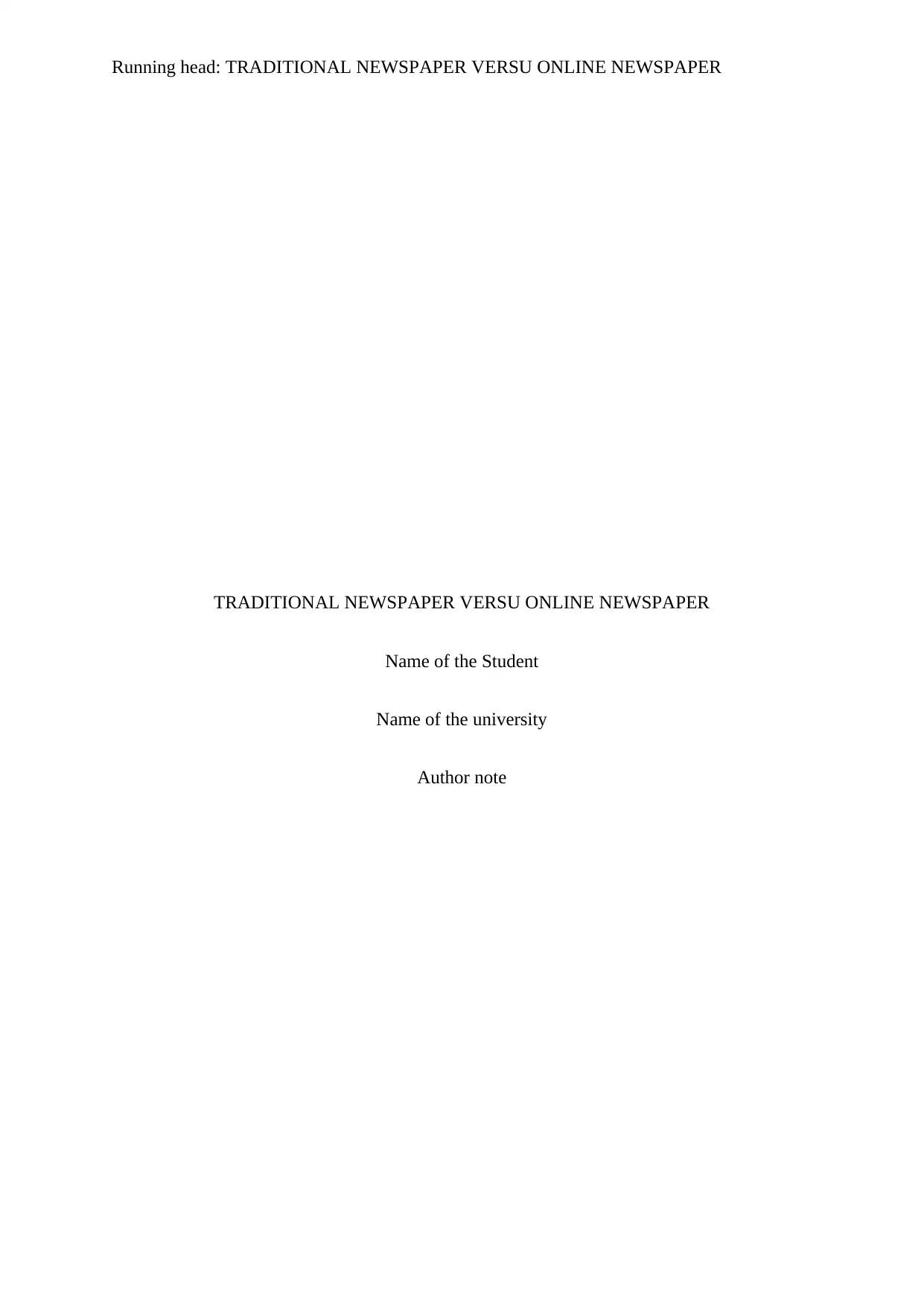
Running head: TRADITIONAL NEWSPAPER VERSU ONLINE NEWSPAPER
TRADITIONAL NEWSPAPER VERSU ONLINE NEWSPAPER
Name of the Student
Name of the university
Author note
TRADITIONAL NEWSPAPER VERSU ONLINE NEWSPAPER
Name of the Student
Name of the university
Author note
Paraphrase This Document
Need a fresh take? Get an instant paraphrase of this document with our AI Paraphraser
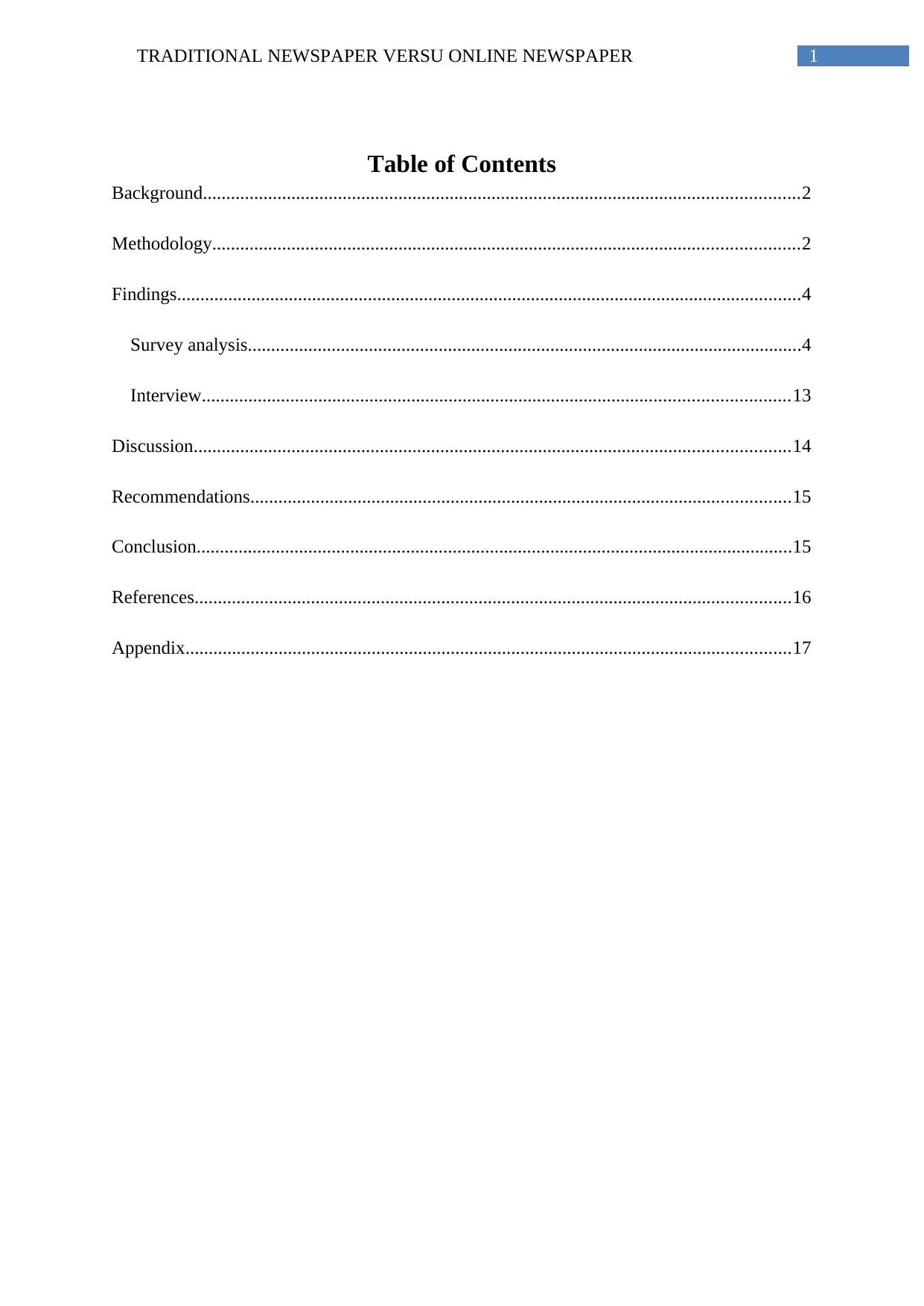
1TRADITIONAL NEWSPAPER VERSU ONLINE NEWSPAPER
Table of Contents
Background................................................................................................................................2
Methodology..............................................................................................................................2
Findings......................................................................................................................................4
Survey analysis.......................................................................................................................4
Interview..............................................................................................................................13
Discussion................................................................................................................................14
Recommendations....................................................................................................................15
Conclusion................................................................................................................................15
References................................................................................................................................16
Appendix..................................................................................................................................17
Table of Contents
Background................................................................................................................................2
Methodology..............................................................................................................................2
Findings......................................................................................................................................4
Survey analysis.......................................................................................................................4
Interview..............................................................................................................................13
Discussion................................................................................................................................14
Recommendations....................................................................................................................15
Conclusion................................................................................................................................15
References................................................................................................................................16
Appendix..................................................................................................................................17
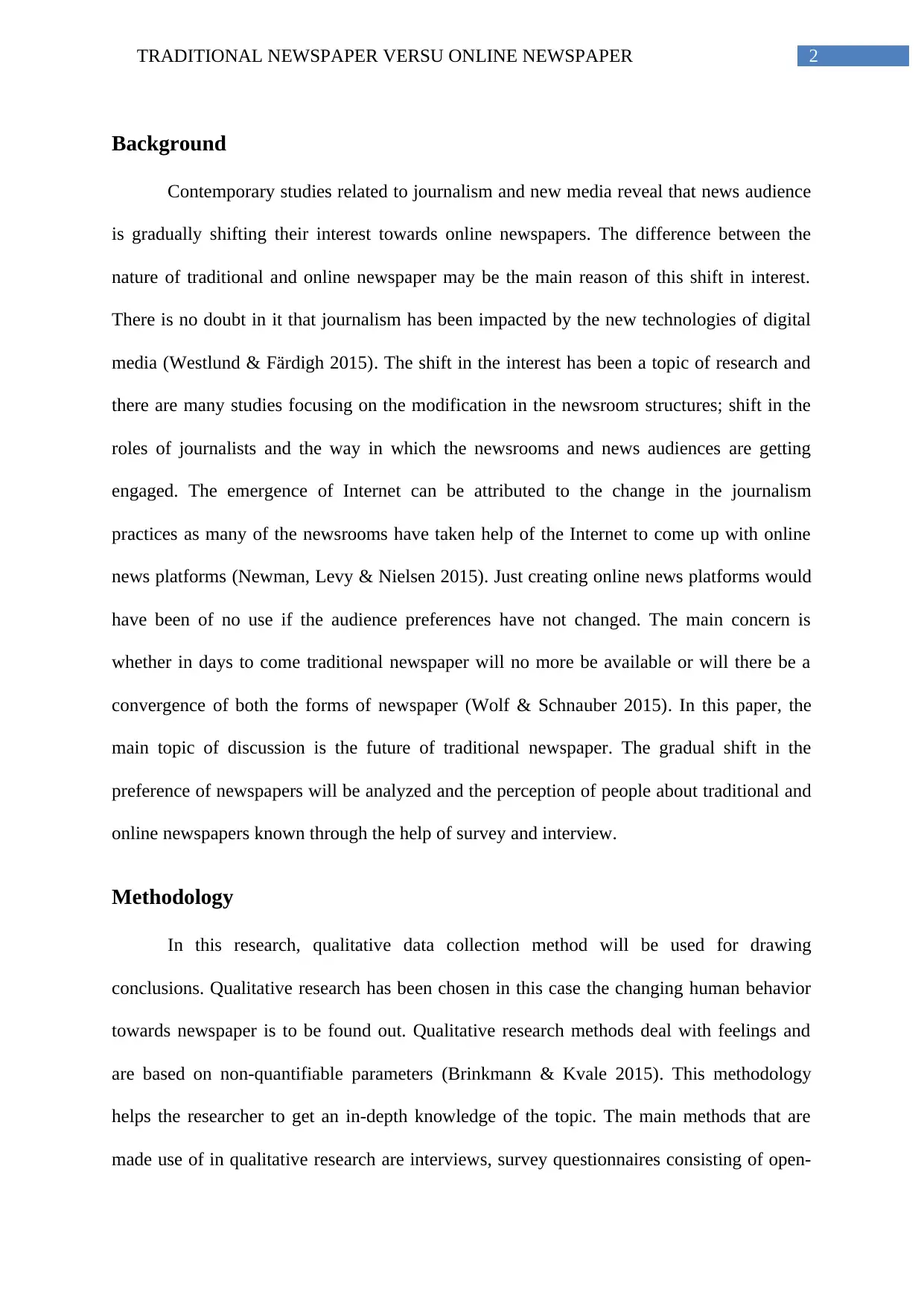
2TRADITIONAL NEWSPAPER VERSU ONLINE NEWSPAPER
Background
Contemporary studies related to journalism and new media reveal that news audience
is gradually shifting their interest towards online newspapers. The difference between the
nature of traditional and online newspaper may be the main reason of this shift in interest.
There is no doubt in it that journalism has been impacted by the new technologies of digital
media (Westlund & Färdigh 2015). The shift in the interest has been a topic of research and
there are many studies focusing on the modification in the newsroom structures; shift in the
roles of journalists and the way in which the newsrooms and news audiences are getting
engaged. The emergence of Internet can be attributed to the change in the journalism
practices as many of the newsrooms have taken help of the Internet to come up with online
news platforms (Newman, Levy & Nielsen 2015). Just creating online news platforms would
have been of no use if the audience preferences have not changed. The main concern is
whether in days to come traditional newspaper will no more be available or will there be a
convergence of both the forms of newspaper (Wolf & Schnauber 2015). In this paper, the
main topic of discussion is the future of traditional newspaper. The gradual shift in the
preference of newspapers will be analyzed and the perception of people about traditional and
online newspapers known through the help of survey and interview.
Methodology
In this research, qualitative data collection method will be used for drawing
conclusions. Qualitative research has been chosen in this case the changing human behavior
towards newspaper is to be found out. Qualitative research methods deal with feelings and
are based on non-quantifiable parameters (Brinkmann & Kvale 2015). This methodology
helps the researcher to get an in-depth knowledge of the topic. The main methods that are
made use of in qualitative research are interviews, survey questionnaires consisting of open-
Background
Contemporary studies related to journalism and new media reveal that news audience
is gradually shifting their interest towards online newspapers. The difference between the
nature of traditional and online newspaper may be the main reason of this shift in interest.
There is no doubt in it that journalism has been impacted by the new technologies of digital
media (Westlund & Färdigh 2015). The shift in the interest has been a topic of research and
there are many studies focusing on the modification in the newsroom structures; shift in the
roles of journalists and the way in which the newsrooms and news audiences are getting
engaged. The emergence of Internet can be attributed to the change in the journalism
practices as many of the newsrooms have taken help of the Internet to come up with online
news platforms (Newman, Levy & Nielsen 2015). Just creating online news platforms would
have been of no use if the audience preferences have not changed. The main concern is
whether in days to come traditional newspaper will no more be available or will there be a
convergence of both the forms of newspaper (Wolf & Schnauber 2015). In this paper, the
main topic of discussion is the future of traditional newspaper. The gradual shift in the
preference of newspapers will be analyzed and the perception of people about traditional and
online newspapers known through the help of survey and interview.
Methodology
In this research, qualitative data collection method will be used for drawing
conclusions. Qualitative research has been chosen in this case the changing human behavior
towards newspaper is to be found out. Qualitative research methods deal with feelings and
are based on non-quantifiable parameters (Brinkmann & Kvale 2015). This methodology
helps the researcher to get an in-depth knowledge of the topic. The main methods that are
made use of in qualitative research are interviews, survey questionnaires consisting of open-
⊘ This is a preview!⊘
Do you want full access?
Subscribe today to unlock all pages.

Trusted by 1+ million students worldwide
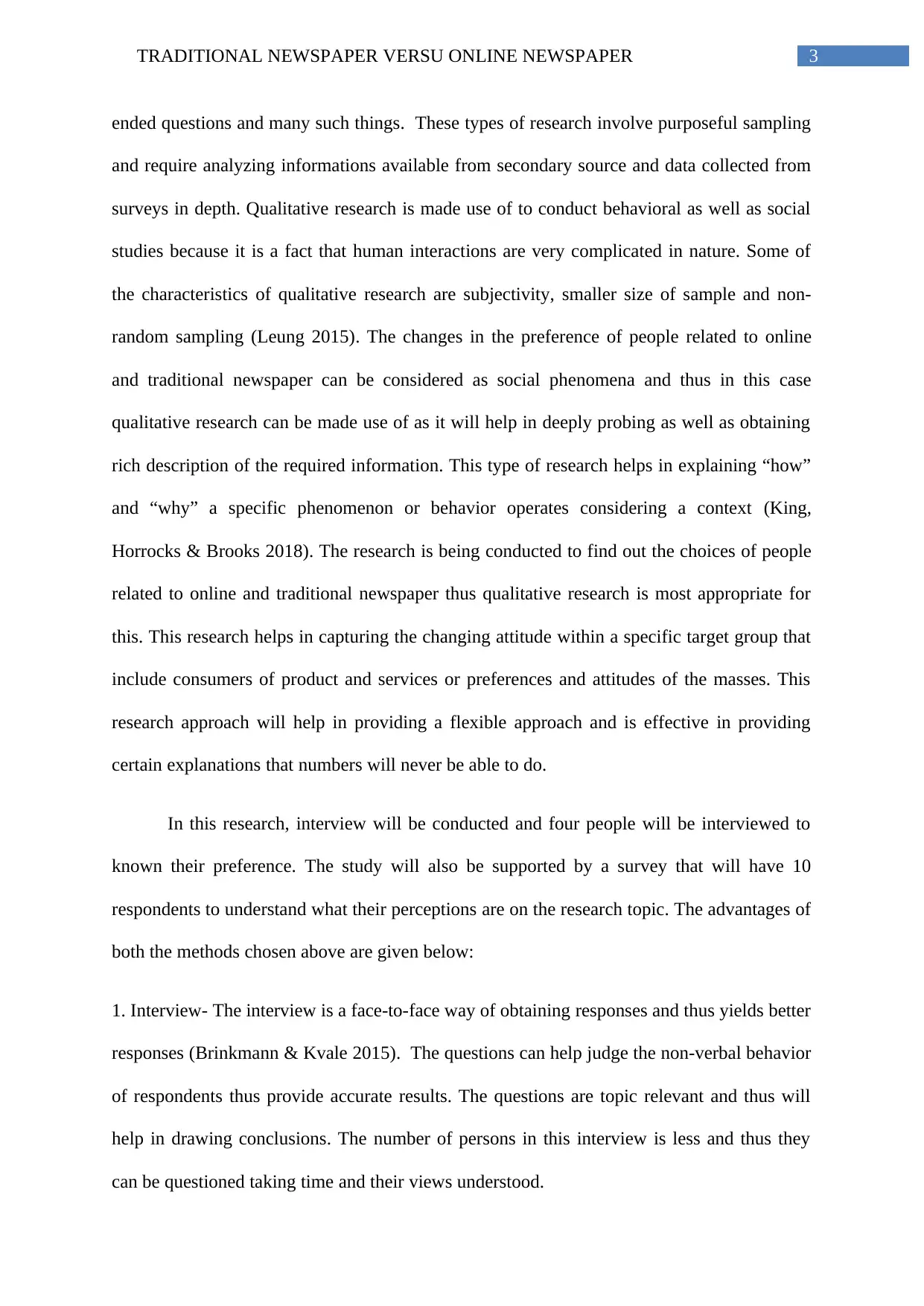
3TRADITIONAL NEWSPAPER VERSU ONLINE NEWSPAPER
ended questions and many such things. These types of research involve purposeful sampling
and require analyzing informations available from secondary source and data collected from
surveys in depth. Qualitative research is made use of to conduct behavioral as well as social
studies because it is a fact that human interactions are very complicated in nature. Some of
the characteristics of qualitative research are subjectivity, smaller size of sample and non-
random sampling (Leung 2015). The changes in the preference of people related to online
and traditional newspaper can be considered as social phenomena and thus in this case
qualitative research can be made use of as it will help in deeply probing as well as obtaining
rich description of the required information. This type of research helps in explaining “how”
and “why” a specific phenomenon or behavior operates considering a context (King,
Horrocks & Brooks 2018). The research is being conducted to find out the choices of people
related to online and traditional newspaper thus qualitative research is most appropriate for
this. This research helps in capturing the changing attitude within a specific target group that
include consumers of product and services or preferences and attitudes of the masses. This
research approach will help in providing a flexible approach and is effective in providing
certain explanations that numbers will never be able to do.
In this research, interview will be conducted and four people will be interviewed to
known their preference. The study will also be supported by a survey that will have 10
respondents to understand what their perceptions are on the research topic. The advantages of
both the methods chosen above are given below:
1. Interview- The interview is a face-to-face way of obtaining responses and thus yields better
responses (Brinkmann & Kvale 2015). The questions can help judge the non-verbal behavior
of respondents thus provide accurate results. The questions are topic relevant and thus will
help in drawing conclusions. The number of persons in this interview is less and thus they
can be questioned taking time and their views understood.
ended questions and many such things. These types of research involve purposeful sampling
and require analyzing informations available from secondary source and data collected from
surveys in depth. Qualitative research is made use of to conduct behavioral as well as social
studies because it is a fact that human interactions are very complicated in nature. Some of
the characteristics of qualitative research are subjectivity, smaller size of sample and non-
random sampling (Leung 2015). The changes in the preference of people related to online
and traditional newspaper can be considered as social phenomena and thus in this case
qualitative research can be made use of as it will help in deeply probing as well as obtaining
rich description of the required information. This type of research helps in explaining “how”
and “why” a specific phenomenon or behavior operates considering a context (King,
Horrocks & Brooks 2018). The research is being conducted to find out the choices of people
related to online and traditional newspaper thus qualitative research is most appropriate for
this. This research helps in capturing the changing attitude within a specific target group that
include consumers of product and services or preferences and attitudes of the masses. This
research approach will help in providing a flexible approach and is effective in providing
certain explanations that numbers will never be able to do.
In this research, interview will be conducted and four people will be interviewed to
known their preference. The study will also be supported by a survey that will have 10
respondents to understand what their perceptions are on the research topic. The advantages of
both the methods chosen above are given below:
1. Interview- The interview is a face-to-face way of obtaining responses and thus yields better
responses (Brinkmann & Kvale 2015). The questions can help judge the non-verbal behavior
of respondents thus provide accurate results. The questions are topic relevant and thus will
help in drawing conclusions. The number of persons in this interview is less and thus they
can be questioned taking time and their views understood.
Paraphrase This Document
Need a fresh take? Get an instant paraphrase of this document with our AI Paraphraser
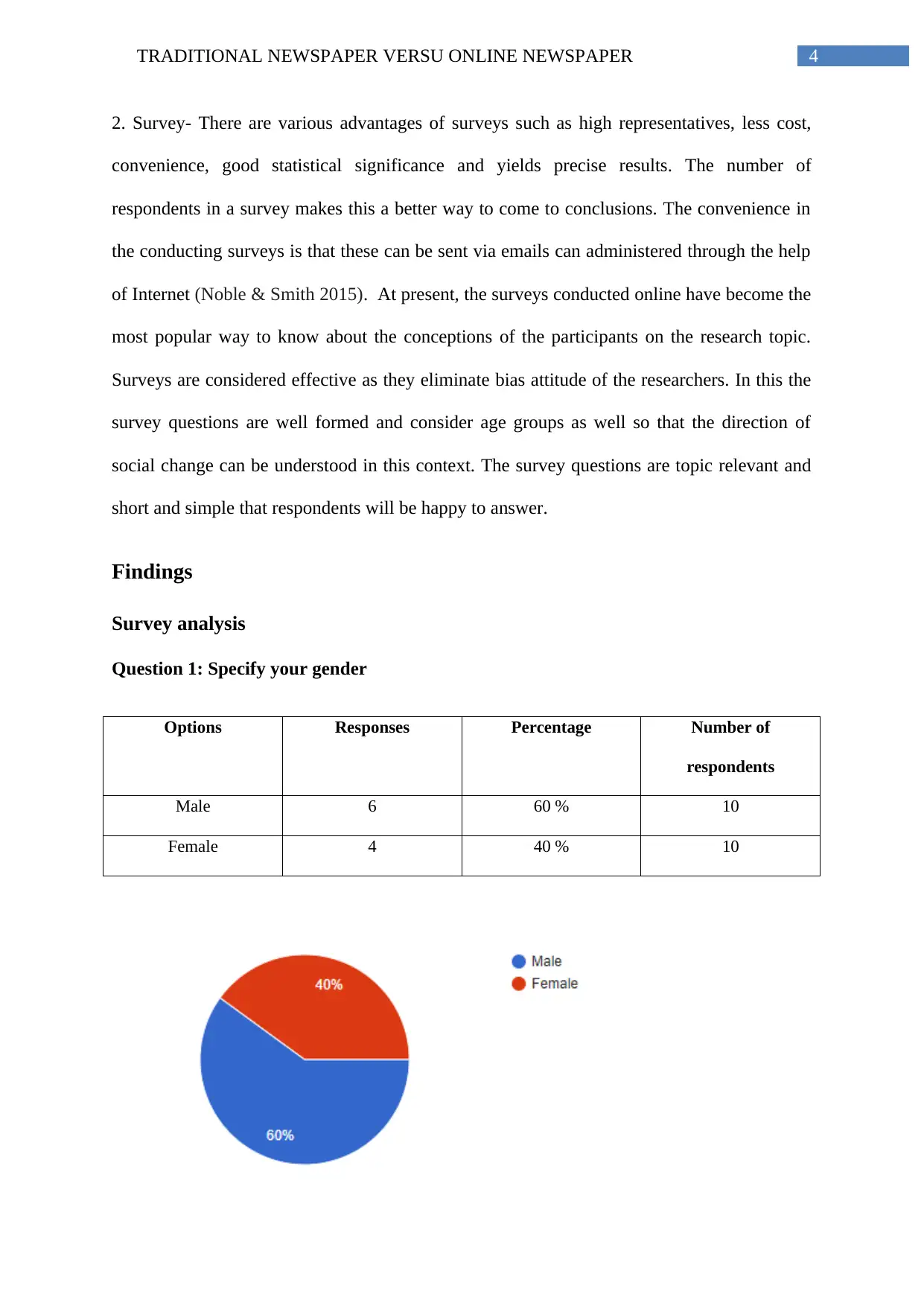
4TRADITIONAL NEWSPAPER VERSU ONLINE NEWSPAPER
2. Survey- There are various advantages of surveys such as high representatives, less cost,
convenience, good statistical significance and yields precise results. The number of
respondents in a survey makes this a better way to come to conclusions. The convenience in
the conducting surveys is that these can be sent via emails can administered through the help
of Internet (Noble & Smith 2015). At present, the surveys conducted online have become the
most popular way to know about the conceptions of the participants on the research topic.
Surveys are considered effective as they eliminate bias attitude of the researchers. In this the
survey questions are well formed and consider age groups as well so that the direction of
social change can be understood in this context. The survey questions are topic relevant and
short and simple that respondents will be happy to answer.
Findings
Survey analysis
Question 1: Specify your gender
Options Responses Percentage Number of
respondents
Male 6 60 % 10
Female 4 40 % 10
2. Survey- There are various advantages of surveys such as high representatives, less cost,
convenience, good statistical significance and yields precise results. The number of
respondents in a survey makes this a better way to come to conclusions. The convenience in
the conducting surveys is that these can be sent via emails can administered through the help
of Internet (Noble & Smith 2015). At present, the surveys conducted online have become the
most popular way to know about the conceptions of the participants on the research topic.
Surveys are considered effective as they eliminate bias attitude of the researchers. In this the
survey questions are well formed and consider age groups as well so that the direction of
social change can be understood in this context. The survey questions are topic relevant and
short and simple that respondents will be happy to answer.
Findings
Survey analysis
Question 1: Specify your gender
Options Responses Percentage Number of
respondents
Male 6 60 % 10
Female 4 40 % 10
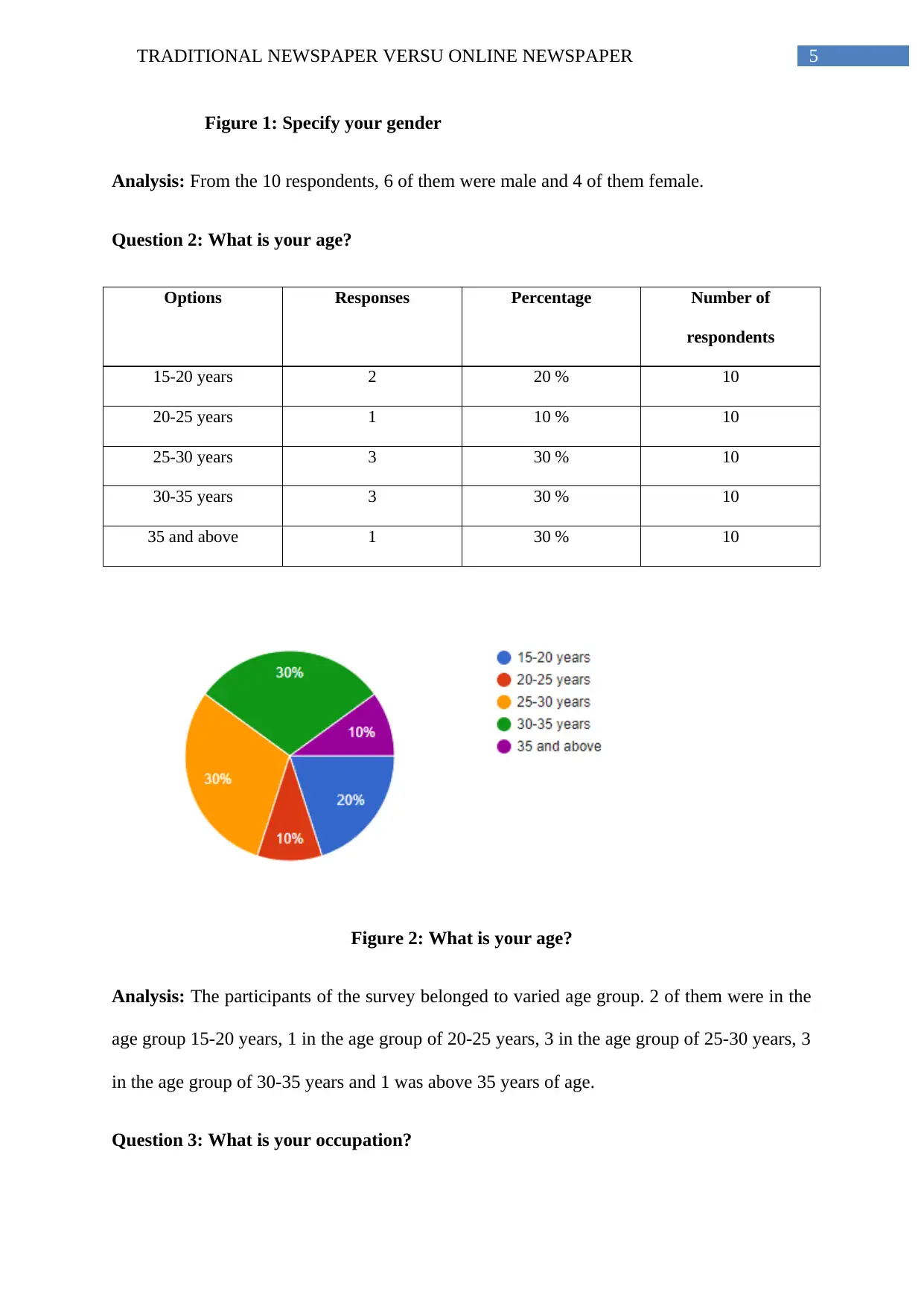
5TRADITIONAL NEWSPAPER VERSU ONLINE NEWSPAPER
Figure 1: Specify your gender
Analysis: From the 10 respondents, 6 of them were male and 4 of them female.
Question 2: What is your age?
Options Responses Percentage Number of
respondents
15-20 years 2 20 % 10
20-25 years 1 10 % 10
25-30 years 3 30 % 10
30-35 years 3 30 % 10
35 and above 1 30 % 10
Figure 2: What is your age?
Analysis: The participants of the survey belonged to varied age group. 2 of them were in the
age group 15-20 years, 1 in the age group of 20-25 years, 3 in the age group of 25-30 years, 3
in the age group of 30-35 years and 1 was above 35 years of age.
Question 3: What is your occupation?
Figure 1: Specify your gender
Analysis: From the 10 respondents, 6 of them were male and 4 of them female.
Question 2: What is your age?
Options Responses Percentage Number of
respondents
15-20 years 2 20 % 10
20-25 years 1 10 % 10
25-30 years 3 30 % 10
30-35 years 3 30 % 10
35 and above 1 30 % 10
Figure 2: What is your age?
Analysis: The participants of the survey belonged to varied age group. 2 of them were in the
age group 15-20 years, 1 in the age group of 20-25 years, 3 in the age group of 25-30 years, 3
in the age group of 30-35 years and 1 was above 35 years of age.
Question 3: What is your occupation?
⊘ This is a preview!⊘
Do you want full access?
Subscribe today to unlock all pages.

Trusted by 1+ million students worldwide
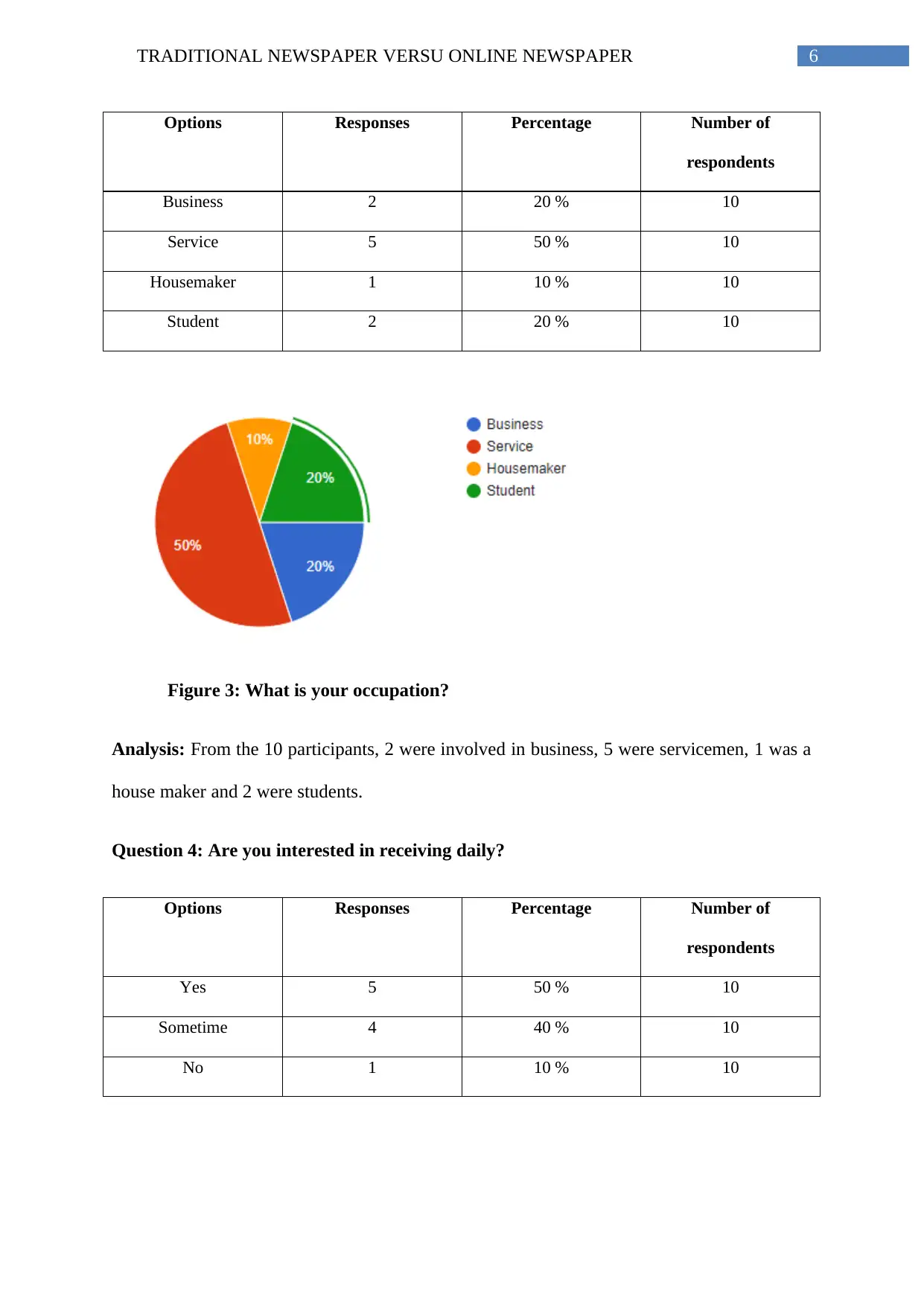
6TRADITIONAL NEWSPAPER VERSU ONLINE NEWSPAPER
Options Responses Percentage Number of
respondents
Business 2 20 % 10
Service 5 50 % 10
Housemaker 1 10 % 10
Student 2 20 % 10
Figure 3: What is your occupation?
Analysis: From the 10 participants, 2 were involved in business, 5 were servicemen, 1 was a
house maker and 2 were students.
Question 4: Are you interested in receiving daily?
Options Responses Percentage Number of
respondents
Yes 5 50 % 10
Sometime 4 40 % 10
No 1 10 % 10
Options Responses Percentage Number of
respondents
Business 2 20 % 10
Service 5 50 % 10
Housemaker 1 10 % 10
Student 2 20 % 10
Figure 3: What is your occupation?
Analysis: From the 10 participants, 2 were involved in business, 5 were servicemen, 1 was a
house maker and 2 were students.
Question 4: Are you interested in receiving daily?
Options Responses Percentage Number of
respondents
Yes 5 50 % 10
Sometime 4 40 % 10
No 1 10 % 10
Paraphrase This Document
Need a fresh take? Get an instant paraphrase of this document with our AI Paraphraser
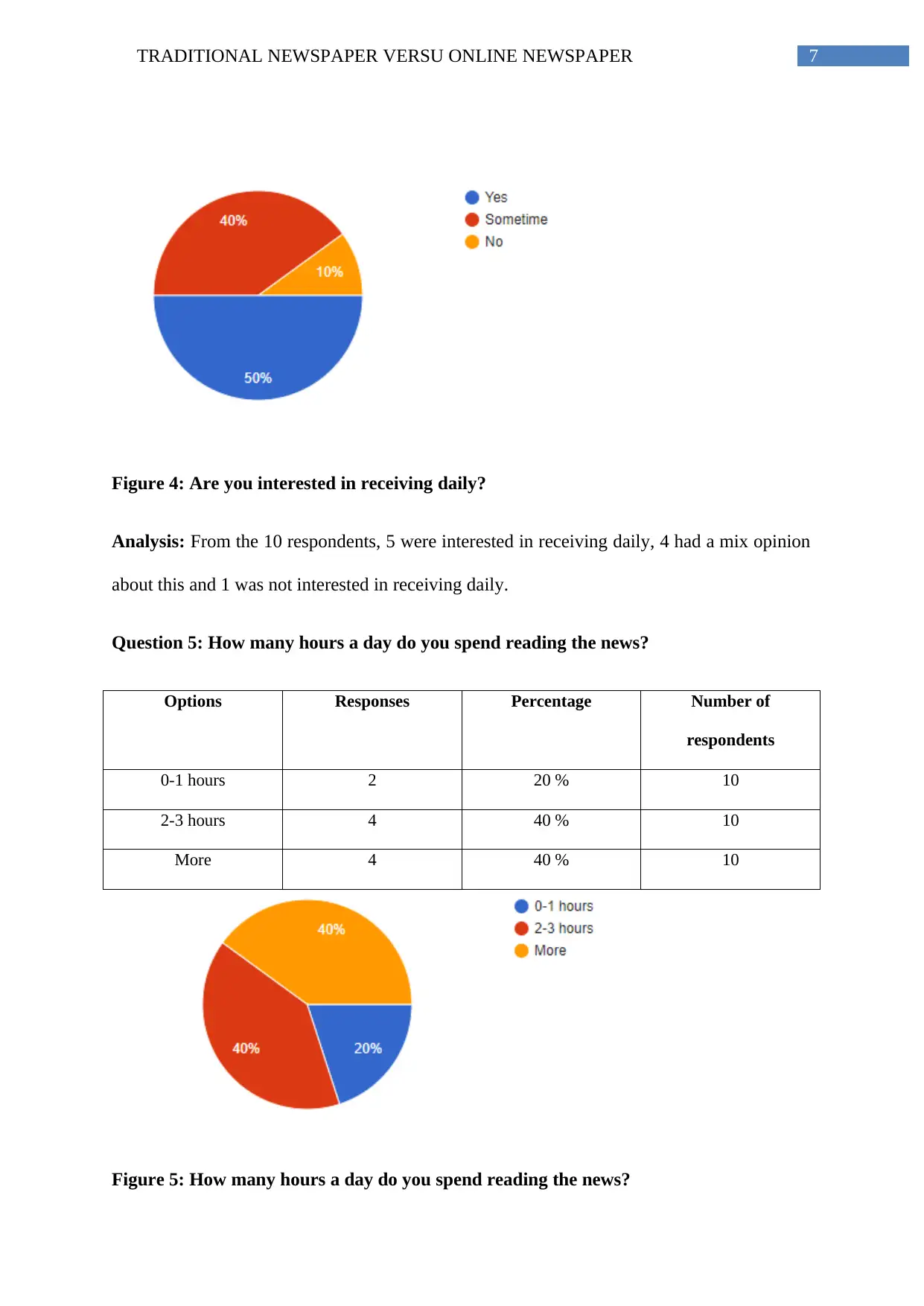
7TRADITIONAL NEWSPAPER VERSU ONLINE NEWSPAPER
Figure 4: Are you interested in receiving daily?
Analysis: From the 10 respondents, 5 were interested in receiving daily, 4 had a mix opinion
about this and 1 was not interested in receiving daily.
Question 5: How many hours a day do you spend reading the news?
Options Responses Percentage Number of
respondents
0-1 hours 2 20 % 10
2-3 hours 4 40 % 10
More 4 40 % 10
Figure 5: How many hours a day do you spend reading the news?
Figure 4: Are you interested in receiving daily?
Analysis: From the 10 respondents, 5 were interested in receiving daily, 4 had a mix opinion
about this and 1 was not interested in receiving daily.
Question 5: How many hours a day do you spend reading the news?
Options Responses Percentage Number of
respondents
0-1 hours 2 20 % 10
2-3 hours 4 40 % 10
More 4 40 % 10
Figure 5: How many hours a day do you spend reading the news?
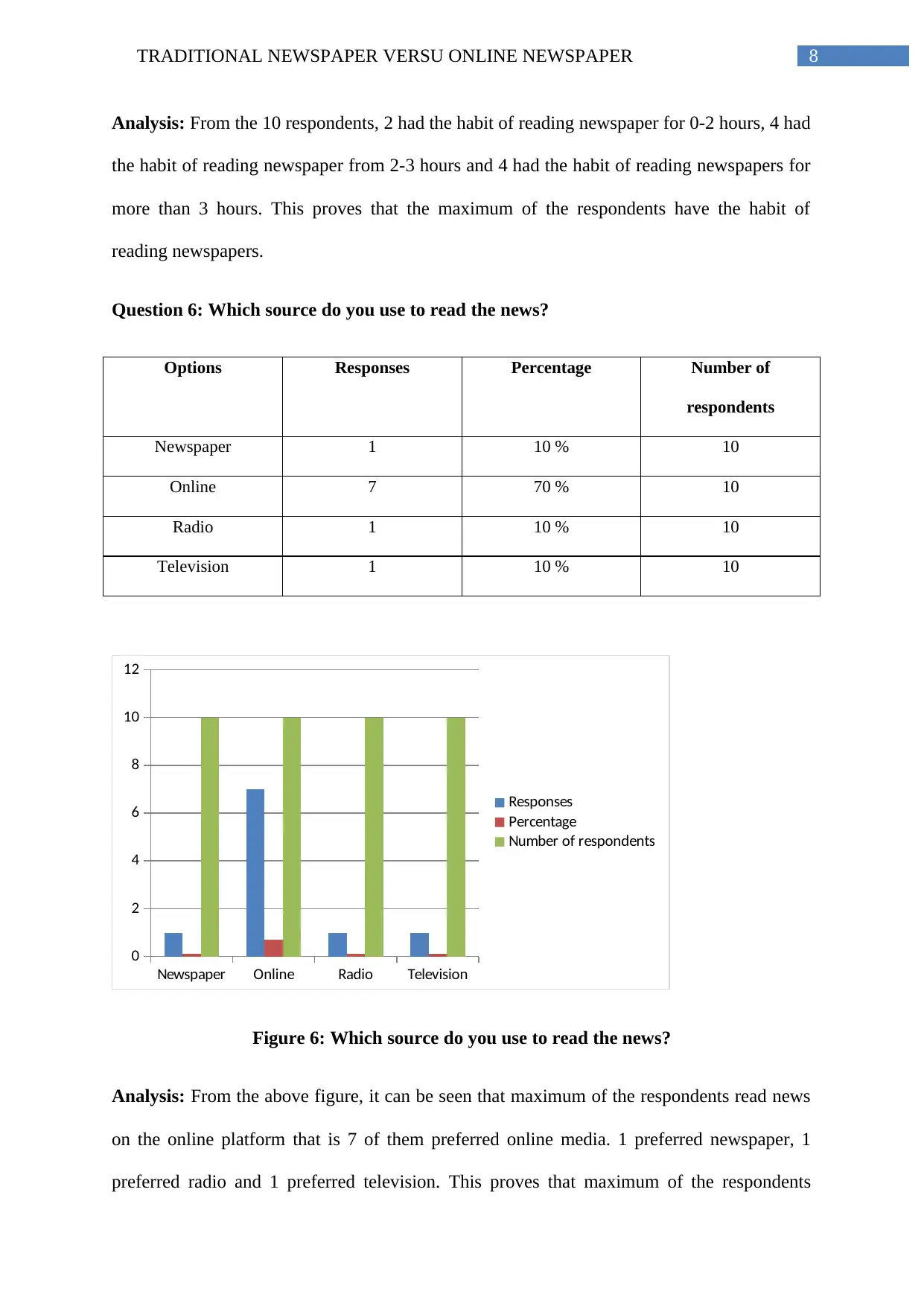
8TRADITIONAL NEWSPAPER VERSU ONLINE NEWSPAPER
Analysis: From the 10 respondents, 2 had the habit of reading newspaper for 0-2 hours, 4 had
the habit of reading newspaper from 2-3 hours and 4 had the habit of reading newspapers for
more than 3 hours. This proves that the maximum of the respondents have the habit of
reading newspapers.
Question 6: Which source do you use to read the news?
Options Responses Percentage Number of
respondents
Newspaper 1 10 % 10
Online 7 70 % 10
Radio 1 10 % 10
Television 1 10 % 10
Newspaper Online Radio Television
0
2
4
6
8
10
12
Responses
Percentage
Number of respondents
Figure 6: Which source do you use to read the news?
Analysis: From the above figure, it can be seen that maximum of the respondents read news
on the online platform that is 7 of them preferred online media. 1 preferred newspaper, 1
preferred radio and 1 preferred television. This proves that maximum of the respondents
Analysis: From the 10 respondents, 2 had the habit of reading newspaper for 0-2 hours, 4 had
the habit of reading newspaper from 2-3 hours and 4 had the habit of reading newspapers for
more than 3 hours. This proves that the maximum of the respondents have the habit of
reading newspapers.
Question 6: Which source do you use to read the news?
Options Responses Percentage Number of
respondents
Newspaper 1 10 % 10
Online 7 70 % 10
Radio 1 10 % 10
Television 1 10 % 10
Newspaper Online Radio Television
0
2
4
6
8
10
12
Responses
Percentage
Number of respondents
Figure 6: Which source do you use to read the news?
Analysis: From the above figure, it can be seen that maximum of the respondents read news
on the online platform that is 7 of them preferred online media. 1 preferred newspaper, 1
preferred radio and 1 preferred television. This proves that maximum of the respondents
⊘ This is a preview!⊘
Do you want full access?
Subscribe today to unlock all pages.

Trusted by 1+ million students worldwide
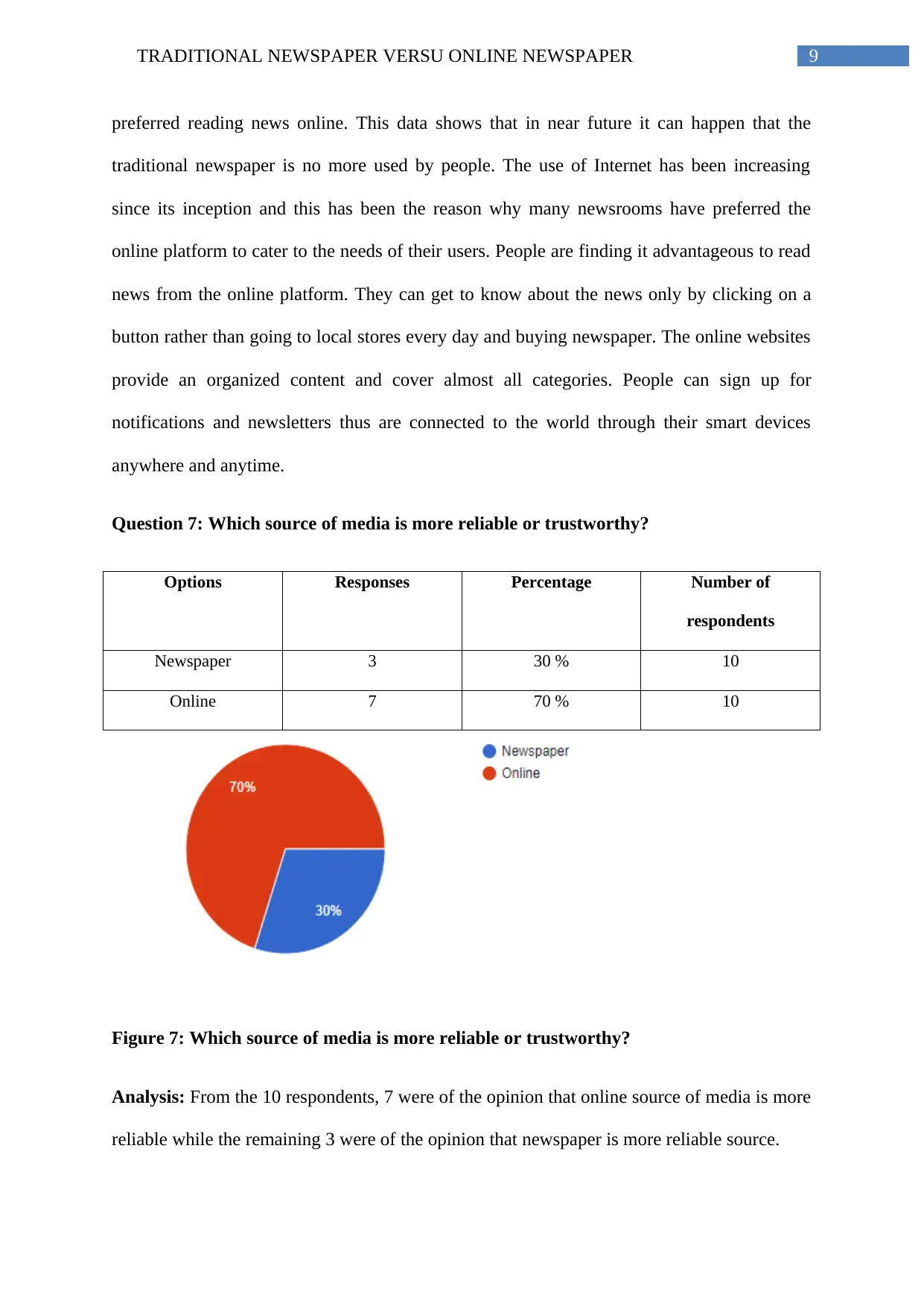
9TRADITIONAL NEWSPAPER VERSU ONLINE NEWSPAPER
preferred reading news online. This data shows that in near future it can happen that the
traditional newspaper is no more used by people. The use of Internet has been increasing
since its inception and this has been the reason why many newsrooms have preferred the
online platform to cater to the needs of their users. People are finding it advantageous to read
news from the online platform. They can get to know about the news only by clicking on a
button rather than going to local stores every day and buying newspaper. The online websites
provide an organized content and cover almost all categories. People can sign up for
notifications and newsletters thus are connected to the world through their smart devices
anywhere and anytime.
Question 7: Which source of media is more reliable or trustworthy?
Options Responses Percentage Number of
respondents
Newspaper 3 30 % 10
Online 7 70 % 10
Figure 7: Which source of media is more reliable or trustworthy?
Analysis: From the 10 respondents, 7 were of the opinion that online source of media is more
reliable while the remaining 3 were of the opinion that newspaper is more reliable source.
preferred reading news online. This data shows that in near future it can happen that the
traditional newspaper is no more used by people. The use of Internet has been increasing
since its inception and this has been the reason why many newsrooms have preferred the
online platform to cater to the needs of their users. People are finding it advantageous to read
news from the online platform. They can get to know about the news only by clicking on a
button rather than going to local stores every day and buying newspaper. The online websites
provide an organized content and cover almost all categories. People can sign up for
notifications and newsletters thus are connected to the world through their smart devices
anywhere and anytime.
Question 7: Which source of media is more reliable or trustworthy?
Options Responses Percentage Number of
respondents
Newspaper 3 30 % 10
Online 7 70 % 10
Figure 7: Which source of media is more reliable or trustworthy?
Analysis: From the 10 respondents, 7 were of the opinion that online source of media is more
reliable while the remaining 3 were of the opinion that newspaper is more reliable source.
Paraphrase This Document
Need a fresh take? Get an instant paraphrase of this document with our AI Paraphraser
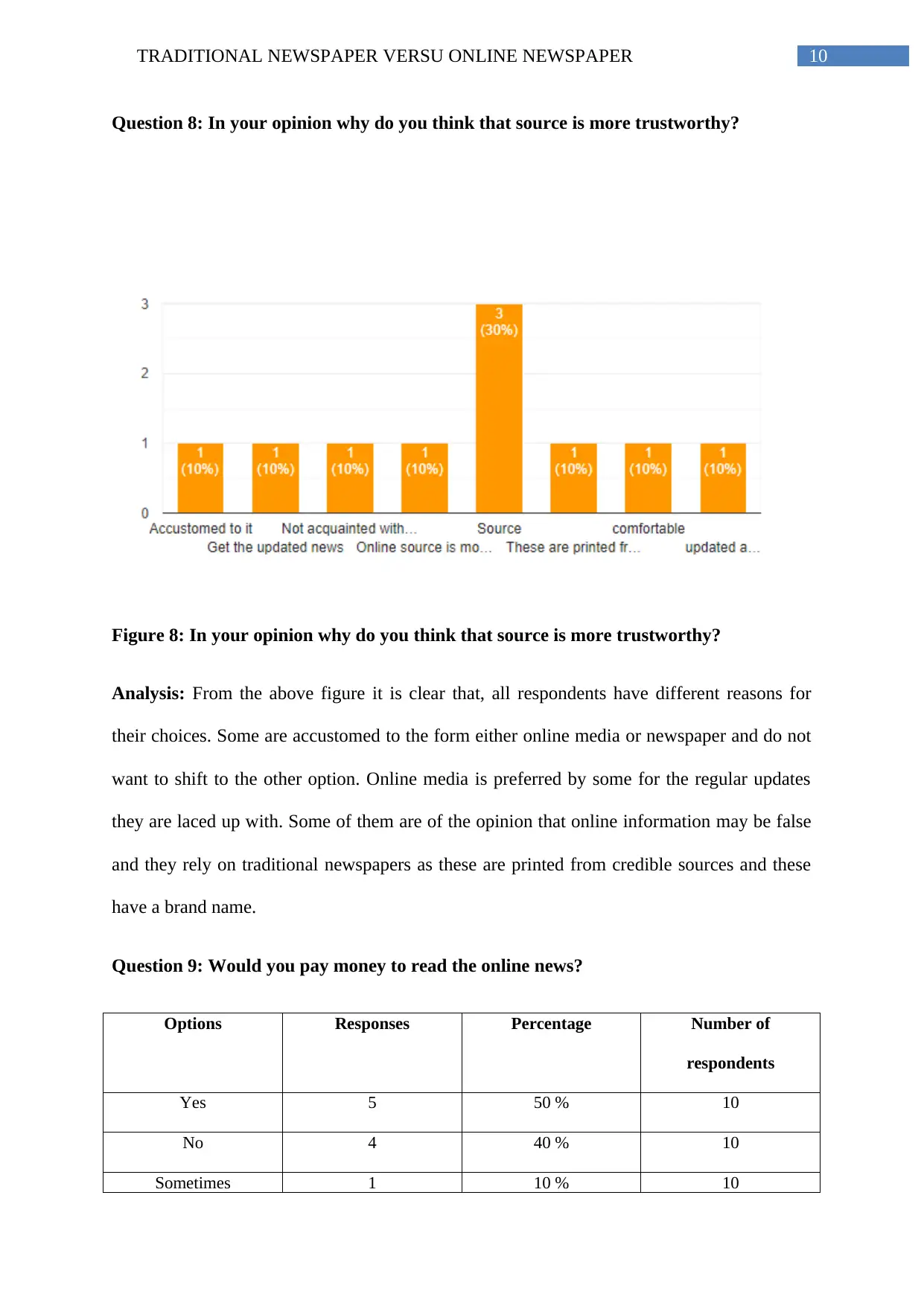
10TRADITIONAL NEWSPAPER VERSU ONLINE NEWSPAPER
Question 8: In your opinion why do you think that source is more trustworthy?
Figure 8: In your opinion why do you think that source is more trustworthy?
Analysis: From the above figure it is clear that, all respondents have different reasons for
their choices. Some are accustomed to the form either online media or newspaper and do not
want to shift to the other option. Online media is preferred by some for the regular updates
they are laced up with. Some of them are of the opinion that online information may be false
and they rely on traditional newspapers as these are printed from credible sources and these
have a brand name.
Question 9: Would you pay money to read the online news?
Options Responses Percentage Number of
respondents
Yes 5 50 % 10
No 4 40 % 10
Sometimes 1 10 % 10
Question 8: In your opinion why do you think that source is more trustworthy?
Figure 8: In your opinion why do you think that source is more trustworthy?
Analysis: From the above figure it is clear that, all respondents have different reasons for
their choices. Some are accustomed to the form either online media or newspaper and do not
want to shift to the other option. Online media is preferred by some for the regular updates
they are laced up with. Some of them are of the opinion that online information may be false
and they rely on traditional newspapers as these are printed from credible sources and these
have a brand name.
Question 9: Would you pay money to read the online news?
Options Responses Percentage Number of
respondents
Yes 5 50 % 10
No 4 40 % 10
Sometimes 1 10 % 10
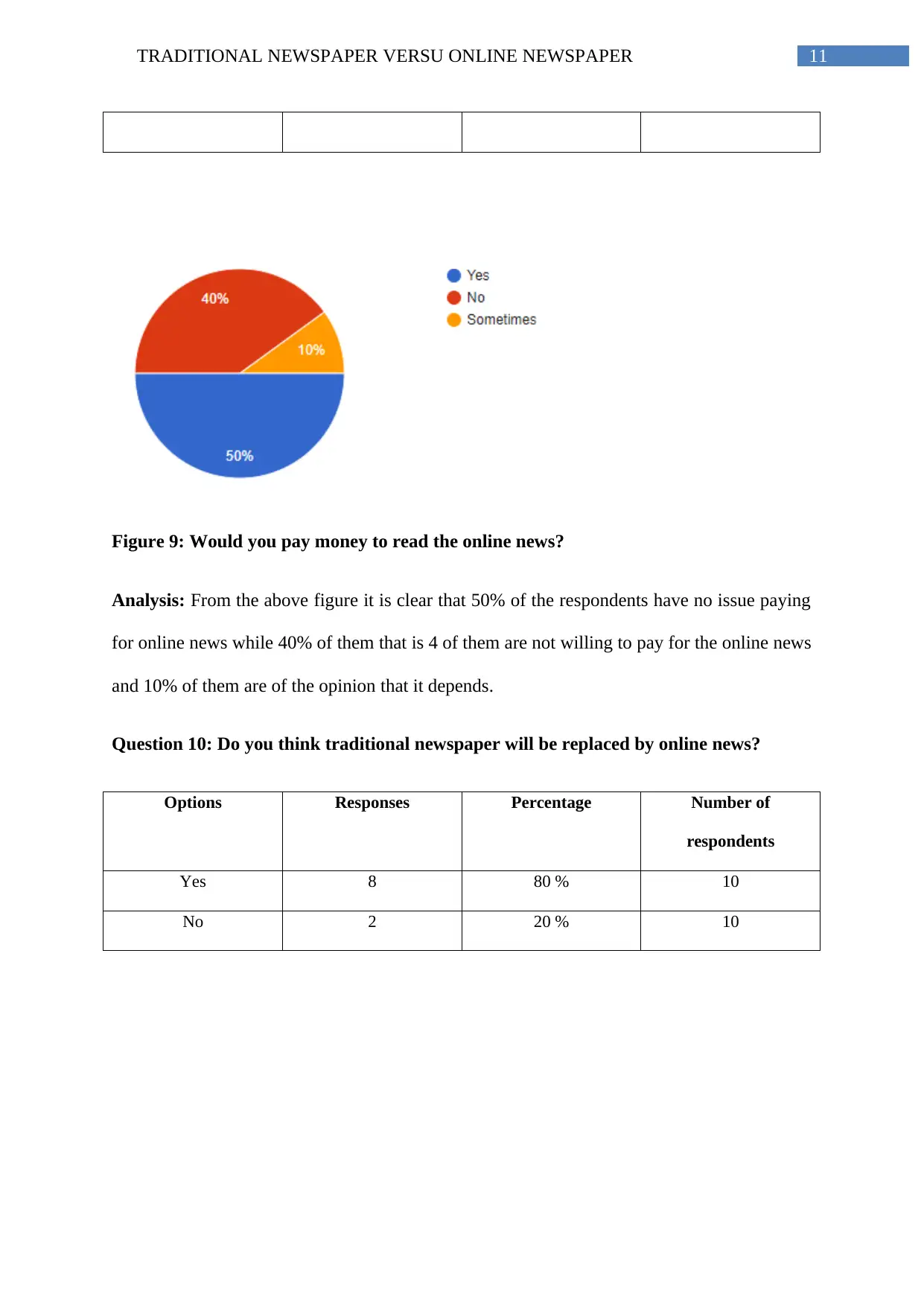
11TRADITIONAL NEWSPAPER VERSU ONLINE NEWSPAPER
Figure 9: Would you pay money to read the online news?
Analysis: From the above figure it is clear that 50% of the respondents have no issue paying
for online news while 40% of them that is 4 of them are not willing to pay for the online news
and 10% of them are of the opinion that it depends.
Question 10: Do you think traditional newspaper will be replaced by online news?
Options Responses Percentage Number of
respondents
Yes 8 80 % 10
No 2 20 % 10
Figure 9: Would you pay money to read the online news?
Analysis: From the above figure it is clear that 50% of the respondents have no issue paying
for online news while 40% of them that is 4 of them are not willing to pay for the online news
and 10% of them are of the opinion that it depends.
Question 10: Do you think traditional newspaper will be replaced by online news?
Options Responses Percentage Number of
respondents
Yes 8 80 % 10
No 2 20 % 10
⊘ This is a preview!⊘
Do you want full access?
Subscribe today to unlock all pages.

Trusted by 1+ million students worldwide
1 out of 21
Related Documents
Your All-in-One AI-Powered Toolkit for Academic Success.
+13062052269
info@desklib.com
Available 24*7 on WhatsApp / Email
![[object Object]](/_next/static/media/star-bottom.7253800d.svg)
Unlock your academic potential
Copyright © 2020–2025 A2Z Services. All Rights Reserved. Developed and managed by ZUCOL.





